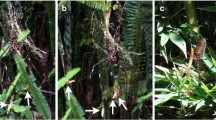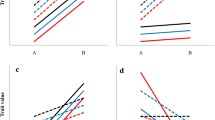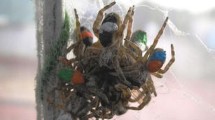Abstract
How animals deal with the challenges posed by their ecological and social surroundings often hinges on the acquisition and storage of information about those surroundings. That is, an animal’s fitness may be influenced by variation in the mental representations it has formed of its environment. Studying such variation is challenging because it involves documenting inherently subjective phenomena. However, observations of behaviour may provide objective descriptions of mental representations. We used the behaviour of Frontinella communis spiders after removal of prey from their webs as an assay of the contents of their memories of the prey. Spiders searched for lost prey, exerting greater effort in searching for larger prey, and distinguishing between the object of the search and old prey remnants. We thus infer that spider memories included information about prey features such as size or quality. We found significant repeatability in the spiders’ searching behaviour, suggesting repeatability in memory content. As an indication of consistent between-individual differences in searching and memory, these repeatability estimates suggest that selection may act to shape mental representations and their relationship with foraging behaviour.


Similar content being viewed by others
References
Balda RP, Kamil AC (1989) A comparative study of cache recovery by three corvid species. Anim Behav 38:486–495
Barth FG (1982) Spiders and vibratory signals: sensory perception and behavioral significance. In: Witt PN, Rovner JS (eds) Spider communication. Mechanisms and ecological significance. Princeton University Press, NJ, pp 68–122
Bell AM (2007) Future directions in behavioural syndromes research. Proc R Soc B 274:755–761
Bell AM, Hankison SJ, Laskowski KL (2009) The repeatability of behaviour: a meta-analysis. Anim Behav 77:771–783
Blackledge TA, Scharff N, Coddington JA, Szüts T, Wenzel JW, Hayashi CY, Agnarsson I (2009) Reconstructing web evolution and spider diversification in the molecular era. Proc Natl Acad Sci USA 106:5229–5234
Borenstein M, Hedges LV, Higgins JPT, Rothstein HR (2009) Introduction to meta–analysis. Wiley, Sussex
Cohen J (1988) Statistical power analysis for the behavioral sciences, 2nd edn. Lawrence Erlbaum Associates, NJ
Coolen I, Dangles O, Casas J (2005) Social learning in noncolonial insects? Curr Biol 15:1931–1935
Day LB, Westcott DA, Olster DH (2005) Evolution of bower complexity and cerebellum size in bowerbirds. Brain Behav Evol 66:62–72
Dukas R (2004) Evolutionary biology of animal cognition. Annu Rev Ecol Evol Syst 35:347–374
Eberhard WG (1986) Effects of orb-web geometry on prey interception and retention. In: Shear WA (ed) Webs behavior and evolution. Stanford University Press, CA, pp 70–100
Eberhard WG (1988) Memory of distances and directions moved as cues during temporary spiral construction in the spider Leucauge mariana (Araneae: Araneidae). J Insect Behav 1:51–66
Eberhard WG (1990) Function and phylogeny of spider webs. Annu Rev Ecol Syst 21:341–372
Farris SM, Roberts NS (2005) Coevolution of generalist feeding ecologies and gyrencephalic mushroom bodies in insects. Proc Natl Acad Sci USA 102:17394–17399
Foelix RF (1996) Biology of spiders, 2nd edn. Oxford University Press, NY
Frank SA (2009) Natural selection maximizes Fisher information. J Evol Biol 22:231–244
Giraldeau LA (2008) Solitary foraging strategies. In: Danchin E, Giraldeau LA, Cézilly F (eds) Behavioural ecology. Oxford University Press, NY, pp 233–255
Giraldeau LA, Valone TJ, Templeton JJ (2002) Potential disadvantages of using socially acquired information. Phil Trans R Soc Lond B 357:1559–1566
Gonda A, Herczeg G, Merilä J (2009) Adaptive brain size divergence in nine-spined sticklebacks (Pungitius pungitius)? J Evol Biol 22:1721–1726
Grostal P, Walter DE (1997) Kleptoparasites or commensals? Effects of Argyrodes antipodianus (Araneane: Theridiidae) on Nephila plumipes (Aranenae: Tetragnathidae). Oecologia 111:570–574
Hamilton IM (2010) Foraging theory. In: Westneat DF, Fox CW (eds) Evolutionary behavioral ecology. Oxford University Press, NY, pp 177–193
Healy S, Braithwaite V (2000) Cognitive ecology: a field of substance? Trends Ecol Evol 15:22–26
Healy SD, Rowe C (2010) Information processing: the ecology and evolution of cognitive abilities. In: Westneat DF, Fox CW (eds) Evolutionary behavioral ecology. Oxford University Press, NY, pp 162–174
Heiling AM, Herberstein ME (1999) The role of experience in web–building spiders (Araneae). Anim Cognit 2:171–177
Herberstein ME, Gaskett AC, Glencross D, Hart S, Jaensch S, Elgar MA (2000) Does the presence of potential prey affect web design in Argiope keyserlingi (Araneae, Araneidae)? J Arachnol 28:346–350
LeGuelte L (1969) Learning in spiders. Am Zool 9:145–152
Lessells CM, Boag PT (1987) Unrepeatable repeatabilities: a common mistake. Auk 104:116–121
Lynch M, Walsh B (1998) Genetics and analysis of quantitatie traits. Sinauer Associates, MA
Madden J (2001) Sex, bowers and brains. Proc R Soc Lond B 268:833–838
Masters WM, Markl HS, Moffat AJM (1986) Transmission of vibration in a spider’s web. In: Shear WA (ed) Webs behavior and evolution. Stanford University Press, CA, pp 49–69
Nakagawa S, Cuthill IC (2007) Effect size, confidence interval and statistical significance: a practical guide for biologists. Biol Rev 82:591–605
Nakata K (2007) Prey detection without successful capture affects spider’s orb–web building behaviour. Naturwissenschaften 94:853–857
Nakata K (2008) Spiders use airborne cues to respond to flying insect predators by building orb–web with fewer silk thread and larger silk decorations. Ethology 114:686–692
Nakata K (2009) To be or not to be conspicuous: the effects of prey availability and predator risk on spider’s web decoration building. Anim Behav 78:1255–1260
Nakata K, Ushimaru A, Watanabe T (2003) Using past experience in web relocation decisions enhances the foraging efficiency of the spider Cyclosa argenteoalba. J Insect Behav 16:371–380
Opell BD (2001) Egg sac recognition by female Miagrammopes animotus (Araenae, Uloboridae). J Arachnol 29:244–248
Overington SE, Morand–Ferron J, Boogert NJ, Lefebvre L (2009) Technical innovations drive the relationship between innovativeness and residual brain size in birds. Anim Behav 78:1001–1010
Pitnick S, Jones KE, Wilkinson GS (2006) Mating system and brain size in bats. Proc R Soc B 273:719–724
Pollen AA, Dobberfuhl AP, Scace J, Igulu MM, Renn SCP, Shumway CA, Hofmann HA (2007) Environmental complexity and social organization sculpt the brain in Lake Tanganyikan cichlid fish. Brain Behav Evol 70:21–39
Pravosudov VV, Clayton NS (2002) A test of the adaptive specialization hypothesis: population differences in caching, memory, and the hippocampus in black-capped chickadees (Poecile atricapilla). Behav Neurosci 116:515–522
Real LA (1993) Toward a cognitive ecology. Trends Ecol Evol 8:413–417
Riechert SE, Gillespie RG (1986) Habitat choice and utilization in web–building spiders. In: Shear WA (ed) Webs behavior and evolution. Stanford University Press, CA, pp 23–48
Rittschof CC, Ruggles KV (2010) The complexity of site quality: multiple factors affect web tenure in an orb–web spider. Anim Behav 79:1147–1155
Robinson MH, Olazarri J (1971) Units of behavior and complex sequences in the predatory behavior of Argiope argentata (Fabricius): (Araneae: Araneidae). Smithson Contrib Zool 65:1–36
Rodríguez RL, Gamboa E (2000) Memory of captured prey in three web spiders (Araneae: Araneidae, Linyphiidae, Tetragnathidae). Anim Cognit 3:91–97
Salomon M (2009) Social environment and feeding state influence movement decisions in a web–building spider. Ethology 115:916–927
Sandoval CP (1994) Plasticity in web design in the spider Parawixia bistriata: a response to variable prey type. Funct Ecol 8:701–707
Shear WA (1986) The evolution of web–building behavior in spiders: a third generation hypothesis. In: Shear WA (ed) Webs behavior and evolution. Stanford University Press, CA, pp 364–400
Shettleworth SJ (2010) Cognition, evolution, and behavior, 2nd edn. Oxford University Press, NY
Sih A, Bell AM, Johnson JC, Ziemba RE (2004) Behavioral syndromes: an integrative overview. Q Rev Biol 79:241–277
Sol D, Duncan RP, Blackburn TM, Cassey P, Lefebvre L (2005) Big brains, enhanced cognition, and response of birds to novel environments. Proc Natl Acad Sci USA 102:5460–5465
Suter RB (1978) Cyclosa turbinata (Areneae: Araneidae): prey discrimination via web–borne vibrations. Behav Ecol Sociobiol 3:283–296
Suter RB (1984) Web tension and gravity as cues in spider orientation. Behav Ecol Sociobiol 16:31–36
Suter RB (1985) Intersexual competition for food in the bowl and doily spider, Frontinella pyramitela (Araneae, Linyphiidae). J Arachnol 13:61–70
Suter RB (1990) Determinants of fecundity in Frontinella pyramitela (Araneae, Linyphiidae). J Arachnol 18:263–269
Turnbull AL (1960) The prey of the spider Linyphia triangularis (Clerck) (Araneae, Linyphiidae). Can J Zool 38:859–873
Venner S, Pasquet A, Leborgne R (2000) Web-building behaviour in the orb–weaving spider Zygiella x–notata: influence of experience. Anim Behav 59:603–611
Vollrath F (1979) Vibrations: their signal function for a spider kleptoparasite. Science 205:1149–1151
Vollrath F (2007) The role of behavior in the evolution of spiders, silks, and webs. Annu Rev Ecol Evol Syst 38:819–846
Vollrath F, Selden P (2007) The role of behavior in the evolution of spiders, silks, and webs. Annu Rev Ecol Evol Syst 38:819–846
Watanabe T (2000) Web tuning of an orb–web spider, Octonoba sybotides, regulates prey-catching behaviour. Proc R Soc Lond B 267:565–569
West–Eberhard MJ (2003) Developmental plasticity and evolution. Oxford Univ, Press, NY
West–Eberhard MJ (2005) Developmental plasticity and the origin of species differences. Proc Natl Acad Sci USA 102:6543–6549
Acknowledgments
We thank Gerlinde Höbel for help in the laboratory and comments to the manuscript. Ted Bach helped collect spiders and conduct trials. Christina Haen weighed and measured crickets and spiders. Nooria Al-Wathiqui, Kasey Fowler–Finn, Elizabeth Jakob, Darren Rebar, Robert Suter and three anonymous reviewers kindly commented on previous versions of the manuscript. Gustavo Hormiga and Mike Draney helped identify the spiders. Raoul Mulder and Peter Dunn gave R advice. This work was supported by NSF grant IOS-0919962 to RLR and by a UWM SURF award to MDG and RLR.
Author information
Authors and Affiliations
Corresponding author
Rights and permissions
About this article
Cite this article
Rodríguez, R.L., Gloudeman, M.D. Estimating the repeatability of memories of captured prey formed by Frontinella communis spiders (Araneae: Linyphiidae). Anim Cogn 14, 675–682 (2011). https://doi.org/10.1007/s10071-011-0402-9
Received:
Revised:
Accepted:
Published:
Issue Date:
DOI: https://doi.org/10.1007/s10071-011-0402-9




